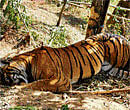
Time-tested foot patrolling is the key to control wildlife poaching. Success stories have often come through dedicated long-term efforts of a few forest officials and their ground staff who believe in fundamental approaches to combat poaching, observes Sanjay Gubbi
Images of confiscated tiger or leopard pelts are a common feature in the Indian media these days. There is an escalation in seizure of wildlife products depicting either increased vigil by enforcement authorities or increase in poaching incidences or a combination of the two. Interestingly, the species confiscated are more diverse than earlier. In the past, wildlife products confiscated mostly consisted of parts from rare or commercially prized wildlife species such as tigers, leopards, otters and elephants.
Now, even common species are increasingly finding their place in the list of seized materials. Barn owl, sand boa, soft shell turtle, axis deer and many other commonly found wildlife species are incessantly targeted by poachers. Similarly, the quantity of tiger and leopard pelts, and ivory seized has been on the rise.
It looks like the booming economies of China and South East Asian countries have increased the demand for wildlife products.
Poaching of wildlife happens at two scales, for meat or for body parts. Hunting for meat is largely carried out by individuals or by loosely formed groups targeting high meat yielding species, or species that are high on the list of delectable dishes.
Hunting for body parts is controlled by organised syndicates. Shockingly, loosely knit local poachers are now trying to hunt high value wildlife species to find their way into organised syndicates.
Many accused recently arrested with tiger and leopard pelts confess to have opportunistically poached big cats or collected elephant ivory in the hope of finding ways to sell their valuable catch uncovering a disturbing trend.
Interestingly, several of the people recently arrested trying to buy common wildlife species are from the real estate business. At a period when real estate profits were low, it is believed these entrepreneurs relied on black magic to enhance their profits.
People hunt wildlife for sport, religious reasons, to earn supplementary income and some with large income motivations. Humans have been hunting in the tropical forests for 100,000 years.
So what is alarming about wildlife poaching? The fact that the scale and consumption levels have gone beyond sustainable levels, at least in the Indian context. Science says that wild meat hunting will be unsustainable when human densities exceed one person/square kilometer. Unlike in some parts of Africa, South America and small parts of India, people do not depend on wild meat as a primary source of protein.
Wherever hunting is sustainable, it is only due to the fact that human densities are so low that offtakes do not make any dent on wildlife populations.
Effects of hunting
Hunting is a loser’s game. It affects wildlife at various intensities including at individual, population and landscape levels. Hunting leads to decreased wildlife densities. In some cases, even if the species is not locally extinct, it would not be performing its ecological functions due to the miniscule numbers; hence it can be considered ‘ecologically extinct’. Hunting of bird species such as hornbills, which provide key ecosystem services through seed dispersal, could upset the forest complex, as plant species dependent on hornbills for dispersal can go locally extinct.
India lost tigers from Sariska and Panna tiger reserves during the last decade and the media increasingly reports stories of confiscated wildlife products. So have we taken our eye off the ball? Increasingly, our focus and determination to carry out old fashioned activities has given way to other conservation enforcement strategies.
The time-tested foot patrolling is the key to control wildlife poaching. Success stories, at least in parts, have come through dedicated long-term efforts of a few forest officials well supported by their ground team who believed in this fundamental practice to combat poaching. Wildlife numbers bounced back under these situations.
Currently, even with increased resources and the best of legislations, few believe in this reliable system. A snare or a jaw trap can be detected only through foot patrolling; there is no alternative to this and unfortunately few care about this.
Behavioural changes in people will take a long time to become a reality. Till people wholeheartedly stop killing wildlife, we need our foot soldiers to scan, monitor, and handle poaching as a primary conservation threat. However, to make them more effective and keep them motivated, we need to enhance the incentives provided to these trench warriors.
A forest watcher continues to languish in the hot and humid jungles with little amenities. To improve his condition, he needs full support of those key people in decision making positions.
It will be foolhardy not to recognise this renewed conservation threat and appropriately implement strategies to save our endangered wildlife species.
Needless to say our hard learnt lessons from Sariska and Panna will mean very little in the larger conservation context.